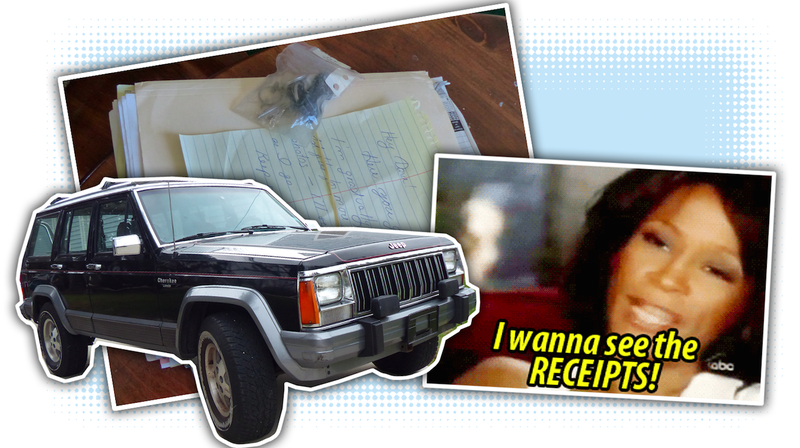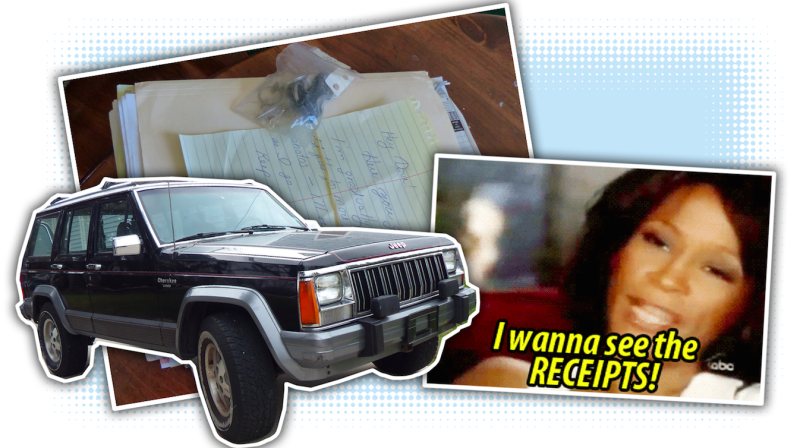
Every time you take your car in to a dealership for a repair or even a minor service, you get a receipt. Over 20 years, those receipts can pile up into a thick wad that you may be tempted to throw away. Don’t. Keep those receipts forever, especially if you plan to sell that vehicle at some point. My 1991 Jeep Cherokee’s incredibly detailed receipts are a great example why.
A couple of months ago, I went through hell to get my hands on a 1991 Jeep Cherokee. It was a manual with vent windows, and it had very little rust, so I would have done almost anything to take ownership of that rare machine.
I ended up dropping $2,000 on the vehicle at a buy here-pay here used car dealership in Indianapolis. And while that’s a lot to spend on a salvage title XJ, I just received something in the mail that made me abandon any thoughts that I got ripped off: full service records.
Or at least, as close to full as I’ve ever seen. The receipts are numerous and incredibly detailed.
Advertisement
The first thing in the envelope sent to me by the previous owner is the original dealership sticker in almost mint condition. There’s not a whole lot of practical use to it, other than that it confirms how the car should be configured, which can help if you want to restore the thing back to factory original spec like I do. But for the most part, it’s more of a novelty that, to collectors, tends to add a bit of value.
But what really adds value to the vehicle are the service receipts. When you buy a used car, it may run, drive, and sound great. But it’s hard to determine how long a vehicle and its many subsystems will last based on how it appears to operate today. What you need to know is how the vehicle has been treated over the long term.
Advertisement
And though there are some components whose health you can easily check (for example, a compression test can be a good indicator of engine health), service records are the most useful bits of information to determine how a car has been cared for over time. Plus, they can help you out when diagnosing a fault. Knowing when certain components were replaced is a godsend.
Major Repairs
For example, I know that my fan clutch was swapped out in 2016. It cost the previous owner $206 (a job that would have cost me $40 and an hour of time—lots of these repairs are extremely pricey):
Advertisement
In 2012, about 15,000 miles ago, the previous owner dropped a staggering $2,300 on the following jobs:
- Service the rear brakes
- Replace the exhaust manifold (which was, presumably, cracked)
- Clean the throttle body
- Replace the spark plugs, throw in a new distributor cap and rotor
- Replace positive crankcase ventilation elbows
- Install a new oxygen sensor
- Fill the rear diff with new fluid and install a new pinion seal.
- Throw on a new rear driveshaft u-joint.
- Put in some new engine mounts
- Fix the oil filter adapter o-ring
- Install a new muffler and tailpipe.
Here are the receipts for that expensive repair:
Advertisement
I also see a receipt from 2004 showing that the front brake calipers, rotors, and hoses were swapped:
Advertisement
Plus, I know that, as of August 2016, my air conditioner worked thanks to a control switch repair. This is great, because I hadn’t even tried my AC:
I also know that the shocks were replaced in 2002:
Advertisement
And 30,000 miles ago, the water pump, thermostat, and drive belts were swapped. If these parts haven’t been swapped more recently than these records show, I’ll probably want to take care of them soon:
Then there’s this $971 service from 2005 that included replacing the steering box and drag link, and—alarmingly—mentions that the side gears in one of the differentials is “very loose,” but does not mention a repair. Here’s to hoping that’s the front axle, since it’s the one I’ll have to replace anyway due to the crash:
Advertisement
Speaking of steering, my power steering pump got replaced in 2009, and “bulk hose” was used for the return line.
This “bulk hose” was fastened with a regular hose clamp, which is now leaking:
Advertisement
This was three years and about 7,000 miles after a power steering hose had apparently sprung a leak, and a mechanic had warned that the lack of power steering fluid may have damaged the pump. He or she was apparently right:
I also know that, in 2009, a new clutch master cylinder was installed:
Advertisement
I don’t see a receipt for a clutch or for a slave cylinder (which is in the transmission bell housing). The previous owner did tell me the slave has been swapped, though, so that’s comforting, even if I’d rather see it on paper.
In 2008, my 1991 Jeep Cherokee’s vents got a clean, and the valve cover gasket got replaced. I found multiple valve cover gasket replacement receipts in this stack; it’s a common problem on 4.0-liter engines.
Advertisement
I also found a bunch of service records that indicate a ghost current draw that was draining the battery. It appears that the source of this issue was discovered in 2007: the glove box door wasn’t closing properly. I’ll have to keep this in mind if I notice my battery draining mysteriously:
I also see that the headlight switch and oil pressure sender was swapped out 12 years and about 30,000 miles ago. Thank goodness, because I hate chasing down electrical gremlins:
Advertisement
As you can tell, a number of big, high-dollar items have been replaced on this Jeep over the years. From steering boxes to power steering pumps to exhaust manifolds, this XJ has been an expensive vehicle to maintain. But hopefully, this means these big-ticket items will last for many years to come.
Fluid Changes
In addition to the major items, it’s the little basic maintenance services that give me high hopes for this XJ. The previous owner took this Jeep in and got its 12,000 mile service done in late 1991.
Advertisement
But not only did he take care of the XJ in the beginning, but based on the service records, it appears that he meticulously maintained this Jeep throughout his over 20 year ownership. Here’ a 1992 receipt showing the Jeep received new gear oil in the axles, new transfer case oil, a fuel filter, and some injector cleaner when the Jeep had about 14,000 miles on the clock:
Advertisement
The receipt also shows complaints about the Jeep occasionally grinding into reverse. This is fairly standard on AX-15 manual transmissions. Two years later, in 1994, it appears that the differentials and the transfer case had their oil changed again, and the transmission got some fresh fluid, too:
I have a number of receipts like this one from earlier this year showing that an oil change was done:
Advertisement
And though I’d like to have seen more transfer case fluid and trans changes than what I see in the records, the gearbox fluid was checked a number of times during, as shown in this 1996 receipt:
Body Damage
Another nice thing about the service records is that I can see if the vehicle has been in an accident. In addition to the recent one that put a big dent in my fender, the Jeep was apparently involved in a crash in 2006, as well:
Advertisement
The repair estimate is about $3,000, and appears to involve repair or replacement of the header panel, front bumper and end caps, and fenders:
There’s Lots of Info On These Receipts
Many of the receipts show what type of fluid was used, where the repair was done, and what vehicle behavior prompted the garage visit in the first place. Plus the papers show the vehicle’s odometer reading, giving a good idea of how much the Jeep has been driven over time. Here’s a plot I made showing just that:
Advertisement
As you can see by the slope of the curve, the previous owner drove this XJ quite a bit in the early years, but as time went on, the vehicle was driven less and less. This isn’t surprising, but it is nice to see that the vehicle has not sat for any extended period of time.
What’s more, I know based on the service records that the vehicle left its rust-free sanctuary of Oregon in late 2016 for the salty mess of Chicago. Based on the records, it appears that the vehicle was only driven about 10,000 miles while there, which explains why the body is in such great shape. And it puts me at ease knowing that I probably won’t find any hidden rust as I comb through the Jeep further.
This plot’s real benefit, though, is pinpointing how long ago the repairs were made, since not all of the receipts have a mileage stamp on them, but nearly all have a date.
Advertisement
Keep Those Receipts
Keeping receipts helps you keep track of what needs to be done to keep your car on the road. And it’s also a great way to make a vehicle more attractive to a future owner.
Advertisement
To the next owner, the records tell the vehicle’s service history over the years—which major parts have been swapped (in my case, it was quite a few parts that commonly fail on XJs), how frequently the fluids were checked and replaced, and what sorts of accidents the car has been involved in. It helps to give an idea of what still needs to be done, taking some of the unwanted surprise out of used vehicle ownership. Plus records help with troubleshooting of future faults.
Even if you can’t really rule out a part just because it’s been recently repaired, the stack of receipts still helps with the diagnostic process, much like how medical records help a doctor determine what’s wrong with someone.
If a human uses records to stay healthy, then surely a car should too. Especially if that car is something as magical as a five-speed 1991 Jeep Cherokee Laredo.















